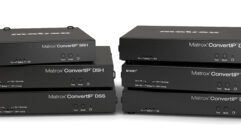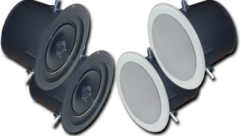The ambiguous frequency response: The BDPR, not the axialresponse, depictshow a given loudspeaker will perform in an actual listening environment.
Jul 1, 1997 12:00 PM,
Jeffrey A. Rocha
One of the most important considerations in sound-system design isconsistency of coverage throughout the entire venue. This consistency isgoverned by both the three-dimensional radiation characteristics of thesound source and the reflective characteristics of the acousticalenvironment. Provided that the former criterion is well-defined andwell-behaved, the latter’s influence can be minimized. Three-dimensionalpolar patterns and modeling tools can assist in evaluating this coverageover the critical octave bands. A further step is the determination of thefull-range, frequency-dependent sound pressure at every seat in the house.The typical axial frequency response can guide the designer in this regardbut only when viewed in conjunction with three-dimensional polar plots andbeamwidth graphs. Fortunately, there is an easier way to determine whethera given loudspeaker meets the criteria of spatially consistent response.
The ambiguous frequency responseThe frequency response of a loudspeaker is most commonly depicted as theaxial pressure response that results from 1 W of electrical input observedat a distance of 1 m. In fact, the term frequency response is almostexclusively used to describe such a graphical representation. The actualdefinition of a frequency response curve, however, reveals that the term ismuch more ambiguous than one might expect.
“A frequency response curve of a loudspeaker is defined as the variation insound pressure [axial response] or acoustic power [power response] as afunction of frequency, with some quantity such as voltage or electricalpower [in watts] held constant.” (Beranek)
By definition, therefore, quantifying the frequency response actuallyrequires the measurer to make two choices regarding the bounds of themeasurement. The argument will be made that the audio industry hashistorically chosen unwisely on both counts. By electing to hold electricalpower constant while measuring sound pressure (as is typically done whenmeasuring frequency response), information that is of little use toconsultants and contractors is produced, at least when taken on its own.Further, by measuring axial sound pressure alone, the industry has deprivedthe design community of a truly useful indication of a loudspeaker’s realworld performance.
Constant input: voltage or electrical power?The frequency response of a loudspeaker is commonly thought of as aquantity that varies with frequency while the electrical power delivered tothe loudspeaker is held at a constant 1 W. The choice of constantelectrical input power for this representation is a poor one. It is almostimpossible to measure any frequency-dependent loudspeaker parameter whilemaintaining a constant input power. In practice, this is never done.
Electrical power is by definition load-dependent. In other words, theamount of electrical power that is delivered to a loudspeaker is dependentupon the loudspeaker’s impedance. Not only do loudspeakers have varyingnominal impedance values (typically 4 V, 8 V or 16 V), but the actualimpedance of a loudspeaker varies dramatically with frequency. An 8 Vnominal loudspeaker may actually range from 6 V to 40 V over its entirebandwidth. (See Figure 1.)
What is measured in practice is the frequency response of the loudspeakeras the input voltage is held constant. Much the same as a 9 V battery is a9 V battery regardless of what it is connected to, the input voltagepresented to a loudspeaker is independent of impedance. Therefore, if aloudspeaker is swept with a 1 V sine wave of varying frequency, the powerbeing delivered to the loudspeaker will vary greatly, but the voltage willalways remain 1 V. Thus, the constant-voltage frequency response provides a better means for the evaluation of a given loudspeaker’s response, particularlywhen viewed in comparison to other devices having dissimilar impedances.
If it is essentially impossible to measure a loudspeaker while maintaininga constant input power, what then is meant by the 1 W designation on mostfrequency response graphs? If an 8 V nominal loudspeaker is depicted ashaving a given frequency response measured with 1 W of input power, thistranslates into a 2.83 V input voltage (P=V2/R, where P is power, V isvoltage and R resistance). Therefore, the manufacturer commonly uses thenominal impedance to determine what input voltage should be used to deliverapproximately 1 W to the loudspeaker. In essence, the inconsistency of thefictitious constant-power frequency response can be overcome simply byunderstanding precisely what is really being measured.
Although this input distinction is somewhat academic provided that theintention of the data is completely understood, one cannot underestimatethe importance of recognizing the frequency dependence of loudspeakerimpedance. Here is a case in point: Ideally, amplifiers areconstant-voltage sources. If one attempts to power an 8 V nominalloudspeaker with 500 W of amplifier output (about 63 V), but theloudspeaker actually has a minimum impedance of 6 V at 200 Hz, then theloudspeaker will be attempting to draw a much higher current (10.S Ainstead of the expected 7.88 A) from the amplifier at 200 Hz. This is allbased on Ohm’s law, V=IR. This condition can quite readily damage bothamplifier and loudspeaker. The situation is of particular concern when theend user attempts to parallel two or more nominal 8 V devices together offof a single amplifier output. In this case the amplifier might be seeingless than a 3 V load over some frequency range. Depending on the amplifier,this problem can be quite detrimental to the system, particularly when theinput level over the low-impedance bandwidth is excessive.
Frequency dependence: sound pressure or acoustical power?It is perhaps easiest to answer this question with a question: Is theintention of the sound system to provide highly intelligible, dynamic,full-range sound to one very important member of the audience who isconsistently seated in a specially located chair, while the rest of theaudience resides in sonic mediocrity? If so, then the axial pressureresponse of the loudspeaker will suffice for performance evaluation. If,however, it is required that every ticket holder or congregation memberobserves the same high caliber of sound reproduction, then a more inclusivemeasurement is required. This measurement is the power response or, statedmore precisely, the power response as observed over the intended coveragearea of the sound source.
The power response of a loudspeaker portrays the sound pressure averagedover all directions of radiation rather than just one. Because professionalloudspeakers are typically designed to achieve broad-band pattern control,it is actually more informative to average this data for only the radiationdirections contained within the intended coverage of the device, henceforthreferred to as the beamwidth delimited power response (BDPR).
In other words, if the loudspeaker is nominally 90 degrees horizontally by40 degrees vertically, then all of the energy radiated through an areadefined by these angles as a function of frequency would be included in theBDPR. In this way, the response of the loudspeaker at any off-axis pointwithin the intended pattern of the system is given as much importance asthe axial response. This point is critical because loudspeakers operate inthree dimensions, and all directions of radiation contribute to the netobserved sound quality of a system.
Beamwidth definedThe beamwidth of a system governs the consistency of the responsethroughout the coverage area. Beamwidth is most commonly defined as theangular distance between two points on either side of the primary axis where the sound pressure is 6 dB below the maximum pressure contained within that angle. This maximum is typically, but not always, found on the primaryaxis. (See Figure 2.)
It is critical to observe not only the point at which the pressure falls to6 dB below the maximum, but also the smoothness and consistency with whichthe pressure falls to this -6 dB point. These factors can be seen in thepolar plots. Ideally the progression is gradual and consistentlydecreasing. The beamwidth, therefore, is both frequency and angledependent. In other words, for every device there is a unique beamwidththat changes with frequency not only in the horizontal and vertical planes,but for every angle in between. Therefore, the ability of the system tomaintain a constant beamwidth for all frequencies within its passband andover the entire intended coverage area will have a direct impact on thepower response. If the axial response is flat and the beamwidth isconsistent, then the resulting BDPR will greatly resemble the axialresponse.
The power responseMost have observed that virtually any loudspeaker can be made to sound orat least measure quite nicely at one point in space. If the measurementmicrophone (or calibrated ear) is then moved to another area within thecoverage of the device, however, the pressure response often looks quitedifferent. In such a case, the loudspeaker diverges from the criticalcriterion of spatial consistency. But why? It is easiest to explain thisphenomena when studying a typical two-way system crossed over in the rangeof 1 kHz to 2 kHz.
In the two-way system we are not interested in the pattern control of thewoofer or horn loaded compression driver alone, but in the beamwidth thatis realized by the complete system. The beamwidth of a woofer decreases asfrequency rises. This occurs as the dimensions of the wavelength begin toapproach and fall below the diameter of the woofer. In a similar fashion,the beamwidth of a horn-loaded compression driver typically increases asfrequency drops. Similarly, this occurs as the wavelength approaches andexceeds the dimensions of the horn mouth height. Unfortunately, the heightof the horn mouth is typically significantly smaller than the diameter ofthe cone. As a consequence, the beamwidth of the horn at crossover issignificantly larger than that of the cone. (See Figure 3.)
If a large woofer is used in conjunction with a relatively small horn in atwo-way system, the beamwidth will typically narrow as the frequencyapproaches crossover. Once the system has been crossed over into the horn,the beamwidth immediately expands due to the size of a wavelength relativeto the mouth dimensions. (See Figure 4.) As frequency continues to rise,beamwidth finally decreases to the nominal horn coverage. This beamwidthdiscontinuity results in a similar discontinuity in the power response.
It should be noted that it is quite simple to manipulate the output ofthese devices such that the axial response looks perfectly flat. As onewalks off the primary axis of the loudspeaker, however, the output from theupper range of the woofer (l kHz to l.5 kHz) would diminish rapidly, whilethe lower horn output (1.5 kHz to 2 kHz) would remain excessive over anarea much larger than the intended coverage. Systems that exhibit theseundesirable characteristics are nearly impossible to array and do notprovide consistent sound throughout a given venue.
The BDPR would readily point out this discontinuity because of the presenceof a dramatic dip and then peak in the response near crossover. In thisparticular case, the system’s shortcomings would also be apparent in thehorizontal or vertical beamwidths. If, however, the beamwidthinconsistencies occur more toward the corners of the horn, the horizontaland vertical beamwidths would not exhibit the flaw, yet it would stillremain readily apparent in the BDPR.
This response measure serves as an accurate representation of theperformance of a loudspeaker over its intended beamwidth, but it also canbe viewed in conjunction witha full three-dimensional power response todetermine the frequency content of any dominant lobes that are projectedoutside of the intended coverage area. These lobes will interfere(frequency-dependent cancellation or summation will be observed) with theradiation from additional nearby sources, significantly minimize gainbefore feedback when projected in the vicinity of live microphones, andcontribute greatly to direct reflections when projected off of rigidboundaries.
In general, we like our loudspeakers to sound great everywhere that theyare supposed to and to be silent everywhere else. Although this goal issomewhat elusive, the power response indicates how closely any deviceapproaches this desired perfection. It should, therefore, be apparent thatpower response is indeed a far better performance indicator than axialsound pressure. But how is it measured?
Power response measurementOne method to arrive at the BDPR of a loudspeaker is to generate theresponse from the data that is required for most modeling software (EASE orCADP2, for example). In order to generate a three-dimensional model ofperformance, the output from the loudspeaker must be acquired for alldirections of radiation. It follows logically that if one were to selectonly the measurements that were made within the intended coverage of thedevice and include them in the finished response measure, then the taskwould be complete. The problem here is that, as a result of the manner inwhich the data is acquired, the calculations involved in manipulating thedata are quite complex.
The data currently required for modeling is gathered at points located atthe intersections of what can be visualized as lines of latitude andlongitude that lie on an imaginary unit sphere that surrounds theloudspeaker. These lines are arranged in 5 degrees increments. (See Figure5.) As can be observed on a world globe, the areas that are formed by theseintersecting lines on a sphere are much larger at the equator than they areat the poles. As a result, a measurement that is taken at a point near thisfictitious equator represents the loudspeaker’s performance over a largerarea than data gathered near the pole. Consequently, the data gathered atevery point must be weighted by a number equivalent to the ratio of itsarea to the area of the complete sphere. As it is a unit sphere, the totalarea is 1. These data manipulations can get quite involved.
In the frequent case when this data is not provided by the manufacturer,there is an easier way to quickly estimate the power response of anindividual loudspeaker. The only requirement is a real time analyzer (RTA)that possesses the capability to continually average the microphone input.Several PC-based RTAs have this capability, and the author has typicallyused the stand-alone dbx RTA-1. The only sacrifice is one of resolution.Most RTAs are limited to some finite percent octave resolution. Theloudspeaker should be driven with a pink-noise source. Actual programmaterial may also be used, but this is best done with program material thatcontains a lot of broadband energy. The measurement microphone should thenbe slowly moved throughout the intended coverage of the device as definedby the nominal beamwidth at a distance of several meters until the entirecoverage area has been traversed a couple of times. The resulting averagedresponse serves as a remarkably accurate depiction of the BDPR. Thesmoothness of this response will dictate how the loudspeaker will performin a three- dimensional sense. For a more in-depth look at the benefits ofthis performance measure, it will be advantageous to walk through anexample.
To demonstrate the effectiveness of the power response in depicting spatialconsistency, two systems were equalized for nearly perfect axial response.One of these systems had an undersized high-frequency horn, about 7 inches(178 mm) tall, paired with a single 15 inch (381 mm) woofer.
The second system had a much larger high-frequency horn with a mouth heightnearly equal to the 15 inch (381mm) diameter of the woofer accompanying it.The axial pressure response and BDPR of each system were measured and aredepicted in Figures 6 and 7. In general, the power response of aloudspeaker should be linear, but will typically exhibit a negative slopebecause of the rising Q of the system. Even in a properly designed system,the Q into three-dimensional space will increase slightly with increasingfrequency because the output through the corners of the horn falls off morerapidly than the output in both the horizontal and vertical planes. Thegraphs below have been normalized to one another so that the initial levelof each is matched to the axial level of the loudspeaker.
In Figure 6 the beamwidth discontinuity results in a dip caused by thenarrowing of the 15 inch (381 mm) woofer polars followed by a peak createdby the wide-open horn coverage. Figure 7, depicting the matched system,exhibits a continuously decreasing response that is the hallmark of awell-designed, spatially consistent loudspeaker.
In typical literature, the technical specifications are accompanied by adepiction of the axial response. The preceding example illustrates thateither of the measured systems would undoubtedly be deemed excellentloudspeakers because of their tremendously linear axial responses. It isonly when one digs deeper and observes the true three-dimensionalperformance that the superior loudspeaker shines. The BDPR serves as a truemeasure of performance that is enormously meaningful to consultants andcontractors. It depicts how a given loudspeaker will perform in an actuallistening environment when in the presence of thousands of listeners andmany reflective surfaces. It holds the key to successful high-performanceinstallations.










